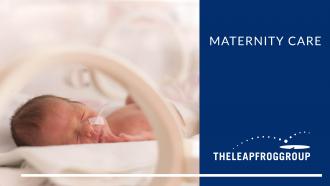
WASHINGTON D.C. – The Leapfrog Group, a national watchdog organization of employers and other purchasers focused on health care safety and quality, today released its 2019 Maternity Care Report. The report is based on results of the 2018 Leapfrog Hospital Survey, with data voluntarily submitted by more than 2,000 U.S. hospitals. It provides an in-depth look at how participating hospitals perform against best practices across three areas of maternity care: cesarean sections, early elective delivery and episiotomy rates. While some hospitals have made strides in maternity quality, only 20% of all hospitals are fully meeting Leapfrog’s standards on all three of these measures.
The report aggregates and analyzes The Leapfrog Group’s reporting by hospital on maternity care and other important indicators of quality. These results and the Maternity Care Report are available for free at www.leapfroggroup.org/compare. Leapfrog is the only source for this unique maternity care data. Because maternity care varies from hospital to hospital, even within the same city, expectant families may access data on hospitals individually when considering a hospital.
The main findings among responding hospitals in the past year compared to when Leapfrog first began collecting data and publicly reporting on these metrics are below:
- Overall, the average rate of early elective deliveries has decreased to 1.5% in 2018, the lowest rate since a 17% starting point in 2010 and well under Leapfrog’s target for hospitals of 5% or less.
- Episiotomy rates have declined from 7.8% in 2017 to 6.9% in 2018, though still above Leapfrog’s target for hospitals of 5% or less.
- The average rate of NTSV cesarean births has remained virtually stagnant since being at 26.4% in 2015, most recently hovering at 26.3% in 2017 and 26.1% in 2018. This is above Leapfrog’s target for hospitals of 23.9%.
“Our report finds good and bad news for expectant mothers,” said Leah Binder, president and CEO of The Leapfrog Group. “But the best news is that more hospitals than ever are transparent about their maternity care quality—something expectant families have sought for a long time. The data suggest that we have a ways to go before hospitals achieve the results the evidence suggests is best for women and babies. Most specifically, the hospitals that families and employers should be most concerned about are those that decline to report their maternity quality. Patients have a right to expect that information, reported through an independent source like Leapfrog, not a hospital press release.”
Studies suggest early elective deliveries, defined as births performed via cesarean section or medical induction prior to 39 completed weeks’ gestation without medical necessity, can pose risks to both mothers and babies. Episiotomy has been associated with perineal tears, loss of bladder or bowel control, and pelvic floor defects that may cause infection, slow recovery and even persist into lifelong discomfort. Cesarean sections can carry serious risks of infection or blood clots, as well as cause some women to experience longer recoveries and chronic pelvic pain. Further research finds babies born by C-section are at increased risk of developing chronic childhood diseases like asthma and diabetes.
“Perhaps the most encouraging finding from our report is that hospitals fully meeting standards across all three measures were more than likely to maintain success in the following year, suggesting that once best practices are prioritized, they become standard operating procedure,” said Binder. “It is this continued success year after year that will have the farthest-reaching impact in giving mothers and children a healthy start.” She pointed out that over 90% of hospitals that achieved Leapfrog standards for early elective deliveries and episiotomy rates repeated that achievement in the following year, and 70% of hospitals that met standards on C-section rates did so again in the following year.
